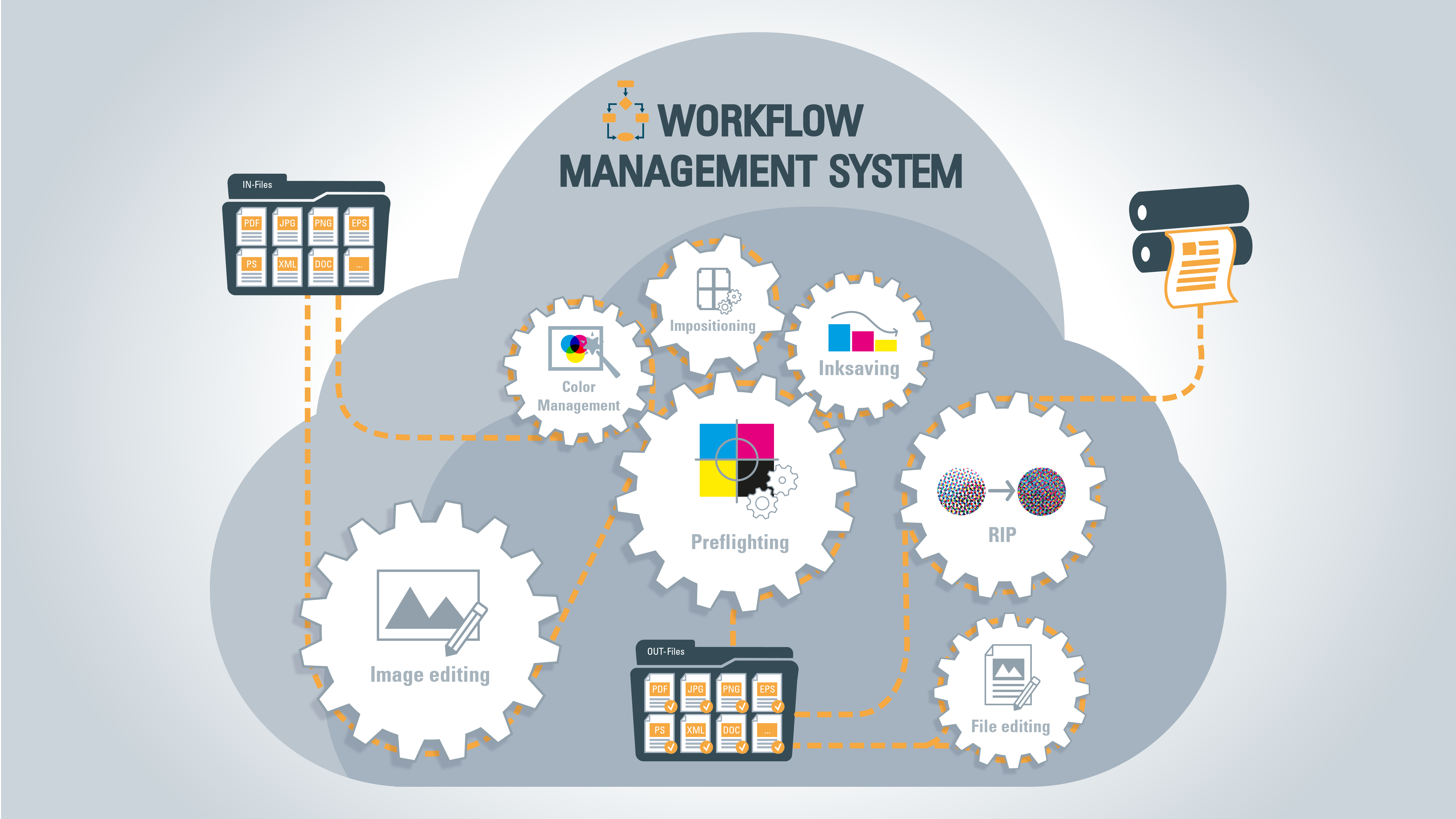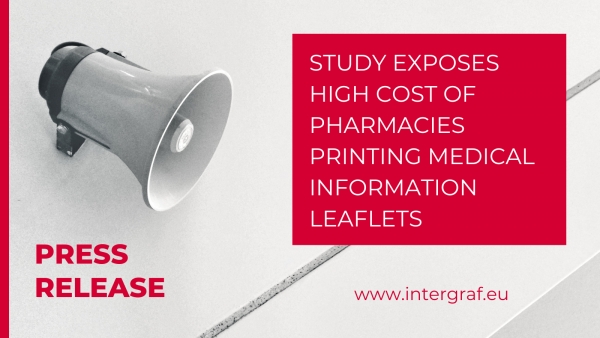19 June 2017

More productivity and effectiveness with Workflow Management Systems
“Industry 4.0” – Combining and automating recurring process steps and the future of production
Industry 4.0 refers to the creation of "smart factories". They are based on a modular structure with cyber-physical systems monitoring physical processes and can communicate and cooperate with each other and with humans in real time via the internet. They can also offer services, both internal and cross-organizational, that are used by participants of the value chain.
So the goal of "Industry 4.0", is not only to automate recurring tasks and single process steps, but to combine them into workflows and to enable the entire workflow to run automatically based on software systems.
In current production environments, providing high-end, quality service or product with the least amount of cost should be the key to success of any business and most print services providers are trying to achieve as much performance as possible to increase their profit. To enable and achieve profitability, various data sources, like MIS/ERP systems, allow worthwhile information to be captured and analysed regarding various aspects of factory production. At this stage, the utilisation of data to understand current operating conditions and detect issues, is an important topic in production and there are various tools available to provide data points for machine cost of ownership (TCO), for example, in order to highlight any concerns and possible faults in the system. Still, the analysis, root cause and action plan to invoke positive change remains a manual one.
Conversely, an "Industry 4.0" production facility will have condition monitoring and fault diagnosis where components and systems are self-learning, able to gain self-awareness and self-prediction, providing management with better insight on the factory status, allowing for systems to trigger required maintenance at the best possible time to reach just-in time maintenance and gain near zero downtime.
Investment in a contemporary automated workflow from the perspective of providers of printing services
In the current market, print service providers are confronted with a series of challenges that impact the future development of their businesses. The complex approach of today's production within the print industry doesn't just include print. Sorry for stating the obvious I know, but clients' needs and expectations result in more print jobs at smaller volumes and higher levels of complexity that include production processes that are not print related. To remain competitive and to ensure customer satisfaction and loyalty, it becomes crucial to, not only reliably and precisely complete a rising number of print jobs with decreasing volumes as fast as possible, but also be in command of production processes regardless of origin - they could be an integral part of your production, or an outsourced service - and they all, if possible, need to be managed from a single process workflow solution if - so you'd like to have your cake and eat it!
Speed, quality and cost are always going to be major factors in a client's choice of where to place production orders. In reality, the customer wants a 'full service' offering - one hand feeds all, so for the print service provider it's the service offering that counts, even if they outsource. Most production jobs, if not all, can be manufactured more efficiently, more effectively and at a lower cost as a result of automation, but how do you manage the clients overall brief? The ability to automate all the processes that are needed to complete the pending order, especially if you don't manage all the steps yourself? The requirement on today's workflow solutions is how well they integrate and communicate with external/other internal systems and the ever growing complexity with the service offerings- now we are back to the "Industry 4.0" environment.
The past and the present
The prepress production process has basically remained the same for a good few years: After job submission - either by email attachment, or by uploading to the FTP server or hot folder - the client transfers his print file to the printer. Subsequent preflighting of the print files initiates a plethora of checks to ensure the correctness of the submitted job. Following steps might include checks on the layout, colour optimization and, if required, images can also be improved/enhanced. Finally, print files will be managed for the specific press requirements for that job. Proofing functions ensure a result that fully meets the clients' expectations. The next steps in the process depend on the print production method.
If the print service provider offers additional services, amendatory process tasks like image optimisation and imposition may already be integrated in the workflow. As these specific production processes always equals a similar pattern, they can be standardised and run completely automatically through a workflow management system:
There are many existing software solutions for single process steps like imposition, automatic content generation (bleed or varnish/white masks), preflighting, image processing and ink-saving. By combining individual software programs with a workflow management system, the entire process can run automatically. Once the print data has been uploaded, the print file automatically undergoes each individual step in the process. Automation of recurring production steps not only reduces the risk of errors whilst reducing turnaround times, but can add other significant advantages to your businesses.
Error avoidance: With an automated workflow, manual interventions are eliminated and therefore all potential error sources - no mistakes and misprints.
Cost reduction: Every single manual process step adds costs. As mentioned earlier, increasing profit margins has to be a focus for any business today, it is a necessity to use the potential savings of an efficiently designed workflow.
Quicker turnaround for print jobs and increased throughput: With comprehensive workflow automation, last-minute changes and customisations can be realised without adjusting deadlines.
Enhanced transparency and traceability: Workflows automatically track clients' jobs. Knowing exactly where a job is in the production process leads to more efficient planning and therefore to a significant reduction in downtime and delays that can frequently arise due to a lack of internal or external communication with the client.
New services, more business - more profit: With the addition of automation, businesses benefit from what is commonly known as "opportunity cost" defined as "the loss of potential gain from other alternatives when one alternative is chosen". So by not automating, what revenue/profit are you losing because you're still doing it manually? Time savings with automation can be huge and be put to better use with your clients. Capitalise on the time saving by capturing more of your clients business.
The future
In my experience, most print service providers nowadays have some sort of automation, but generally they are for specific/certain business areas or domains. As an example, if a print service provider has a wide format printer, digital cut-sheet and offset, they are more than likely to have 3 different "workflow" solutions that are used separately and don't work/talk together. Or maybe they have 3 wide format devices that have 3 digital front ends (DFEs) from various suppliers that are not integrated - commonplace when looking at legacy technology investments.
With the ever growing need to manage clients' jobs across multiple print sectors and beyond, the question then arises "how do you integrate and control all the production processes to allow automated workflow?"
These are the issues that print service providers are dealing with on a daily basis. Someone once told me, and I am now paraphrasing specifically around digital print production, that around 50% of the press operators time is consumed with work that is not related to printing and in that time, the machine/s are idle. Imagine that? Only 50% utilisation on a piece of capital equipment!
So imagine having a process workflow solution that can integrate with and manage all of your current and future technologies. Something that can automate the business production processes based on the client's needs for a specific job. Something that when the print file is delivered to the press, all you need to do is print. A solution that can cross over into other areas to support finishing requirements to the final product. The ideal business production process workflow solution is one that can umbrella existing solutions, products and internal/external services with complete transparency. Maybe even get very close to the so-called "smart factory" solution.
I don't believe that, as an industry, we are yet close to the "all encompassing, off the shelve" solution, but it's clear that to stay competitive in today's print industry and to push innovative business ideas ahead, print service providers need to rely on a fully automated workflow management system. Inroads are being made in certain sectors and finding the right software developer will make all the difference in managing your business objectives. Enabling automation is based on very specific set of needs as no two companies are the same. You will need someone who can work with you to define, bespoke and tailor something individual - as the ideal, self-learning, self-aware systems are not yet available.
OneVision as a partner and software developer
OneVision offers high-performance, extremely flexible software solutions for automating production processes within the graphic arts and printing industries. In addition to software for individual process steps, we offer workflow management systems that allow workflows to be set up individually and run automatically. OneVision's software makes use of unique functionality to filter, sort and route data, whilst supporting metadata, including JDF, XML, XMP, IPTC, and EXIF. As such, OneVision represents the ideal link between MIS, task, job planning systems, prepress workflows, online portals, databases and output digital front ends (DFE).
We can help you to automate tasks that you are still performing via manual processes. By looking at each customers individual needs and with our wide range of intuitive software solutions, OneVision can complete the set of requirements that are driving your businesses in today's printing industries.
For more information please contact Robert Lugg at OneVision at [email protected]
 Intergraf Economic News (Paper Prices) - March 2024
Intergraf Economic News (Paper Prices) - March 2024
18 March 2024
Access the latest edition of the Economic Newsletter for the European Printing Industry for data on paper consumption, and pricing data for pulp, paper and recovered paper. Data for packaging papers and board is also available with this edition.
 STUDY EXPOSES HIGH COST OF PHARMACIES PRINTING MEDICAL INFORMATION LEAFLETS
STUDY EXPOSES HIGH COST OF PHARMACIES PRINTING MEDICAL INFORMATION LEAFLETS
7 March 2024
Intergraf welcomes the release of a study by our partner MLPS (Medical Leaflet = Patient Safety), a subgroup of the European Carton Manufacturers Association (ECMA) shedding light on the potential economic costs associated with the proposed use of Print on Demand (PoD) leaflets in the pharmaceutical legislation revision.
The BPIF is the printing industries champion. By becoming a member you join a diverse and influential community. We help you solve business problems, connect you to new customers and suppliers and make your voice heard in government.
Call 01676 526030









